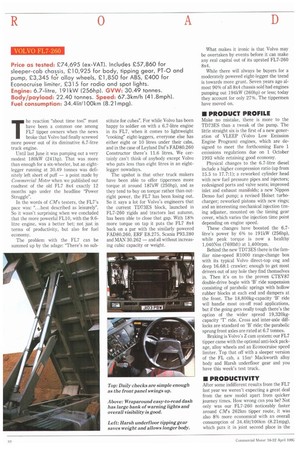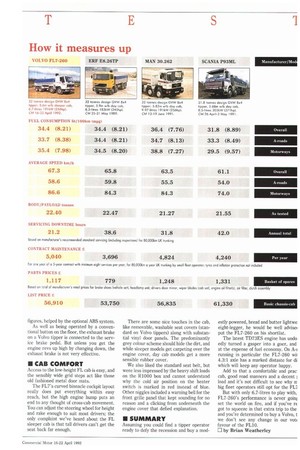T he reaction "about time too!" must have been a common
Page 34

Page 36

Page 37

If you've noticed an error in this article please click here to report it so we can fix it.
one among FL7 tipper owners when the news broke that Volvo had finally screwed more power out of its diminutive 6.7-litre truck engine.
Until last June it was pumping out a very modest 180kW (241hp). That was more than enough for a six-wheeler, but an eightlegger running at 30.49 tonnes was definitely left short of puff — a point made by Commercial Motor when we published our roadtest of the old FL7 8x4 exactly 12 months ago under the headline "Power Struggle".
In the words of CM's testers, the FL7's pace was: "...best described as leisurely". So it wasn't surprising when we concluded that the more powerful FL10, with the 9.6litre engine, was a better bet; not just in terms of productivity, but also for fuel economy.
The problem with the FL7 can be summed up by the adage: "There's no sub
stitute for cubes". For while Volvo has been happy to soldier on with a 6.7-litre engine in its FL7, when it comes to lightweight "cooking" eight-leggers, everyone else has either eight or 10 litres under their cabs, and in the case of Leyland Daf's FAD80.260 Constructor there's 11.6 litres. We certainly can't think of anybody except Volvo who puts less than eight litres in an eightlegger nowadays.
The upshot is that other truck makers have been able to offer tippermen more torque at around 187kW (250bp), and as they tend to buy on torque rather than outright power, the FL7 has been losing out. So it says a lot for Volvo's engineers that the current TD73ES block, launched in FL7-260 rigids and tractors last autumn, has been able to close that gap. With 18% more torque on tap it puts the FL7 8x4 back on a par with the similarly powered FAD80.260, ERF E8.275, Scania P93.280 and MAN 30.262 — and all without increasing cubic capacity or weight. What makes it ironic is that Volvo may be overtaken by events before it can make any real capital out of its uprated FL7-260 8x4.
While there will always be buyers for a moderately powered eight-legger the trend is towards more grunt. Seven years ago almost 90% of all 8x4 chassis sold had engines pumping out 194kW (260hp) or less; today they account for only 27%. The tippermen have moved on.
• PRODUCT PROFILE
Make no mistake, there is more to the TD73ES than a tweak of the pump. The little straight six is the first of a new generation of VLEEP (Volvo Low Emission Engine Program) engines, which are designed to meet the forthcoming Euro 1 emissions regulations due on 1 October 1993 while retaining good economy.
Physical changes to the 6.7-litre diesel include a higher compression ratio (up from 15.5 to 17.7:1); a reworked cylinder head with new fuel pressure pipes and injectors; redesigned ports and valve seats; improved inlet and exhaust manifolds; a new Nippon Denso fuel pump; a revised Holset turbocharger; reworked pistons with new rings; and an interesting mechanical injection timing adjuster, mounted on the timing gear cover, which varies the injection time point depending on engine speed.
These changes have boosted the 6.7litre's power by 6% to 191kW (256hp), while peak torque is now a healthy 1,040Nm (769Ibft) at 1,400rpm.
Behind the new TD73ES there is the familiar nine-speed R1000 range-change box with its typical Volvo direct-top cog and deep 16.68:1 crawler; enough to get most drivers out of any hole they find themselves in, Then it's on to the proven CTEV87 double-drive bogie with 'B' ride suspension consisting of parabolic springs with hollow rubber blocks at each end and dampers at the front. The 18,800kg-capacity 'B' ride will handle most on-off road applications, but if the going gets really tough there's the option of the wider spread 19,320kgcapacity 'T' ride. Cross and inter-axle dufflocks are standard on 'B' ride; the parabolic sprung front axles are rated at 6.7 tonnes.
Braking is Volvo's Z cam system: our FL7 tipper came with the optional anti-lock package, alloy wheels and an Econocruise speed limiter. Top that off with a sleeper version of the FL cab, a 15m3 Mackworth alloy body and Harsh underfloor gear and you have this week's test truck.
• PRODUCTIVITY
After some indifferent results from the FL7 last year we weren't expecting a great deal from the new model apart from quicker journey times. How wrong can you be? Not only was our FL7-260 noticeably faster around CM's 262km tipper route, it was also 8% more economical with an overall consumption of 34.41it/100km (8.21mpg), which puts it in joint second place in the up-to-234kW (300hp) 8x4 fuel league table, alongside the ERF E8. Only the Scania P93ML has proved less thirsty on test, and with much longer journey times.
By far the greatest improvement was over the A-road section of our route. Running with the faster (4.3:1) axle, at 40 and 50mph the TD73ES is spinning well within the green economy band between 1,200 and 2,100rpm. When you get up to the motorway limit the revs rise to 2,200rpm and consumption increases.
Volvo recommends the 4.3:1 axle for motorway running, and in terms of performance we've no argument with that. On the 100km jog up the M1 and M69 the FL7260 had no trouble keeping up with the traffic, despite some blustery winds. But while the little 6.7-litre engine has no problems handling motorway work, it's a lot less thirsty off it.
There are two ways to drive the FL7260. You can rev its nuts off, making every change at the top of the green band at 2,200 (maximum power is developed at 2,400rpm) — and get nowhere slowly.
Alternatively you can sit back and relax, keep the revs to a sensible limit and get that 18% extra torque working for you.
On the road you can easily take most upshifts at around 1,800rpm, which puts the rev needle back close to peak torque at around 1,300-1,400rpm. Stick to this technique and you can't go wrong.
For all its modest displacement the TD73ES will lug down happily to around 1,200rpm and still recover if the slope isn't too severe, but on anything steep you've got to change early and get some revs in hand because below 1,300rpm the torque curve heads for the basement fast.
The only time you ever really need to take the TD73ES out of the green is if you are making a block change — which you can do quite happily in the first five gears — when you need to take the revs just beyond the end of the green.
Despite its extra power and torque the FL7-260 is hardly the fastest thing on four axles. Accelerating up to 80Iun/h it beats the Scania and MAN, but it is beaten by the ERF and the 80.260 Constructor.
A small displacement engine certainly keeps the kerbweight down, as a quick glance at our comparison charts shows, and remember that our eight-legger is the only one in the group with a full sleeper cab.
The FL7-260's 22.40 tonne body/payload allowance is greater than the MAN 30.262's or the Scania P93. With a day cab it would doubtless have equalled the lightweight ERF E8.265; with its sleeper it still carried 20 tonnes and then some.
• ON THE ROAD
You'd have to be pretty picky not to like the FL7-260's road manners. The little eight-legger is very easy to drive; although the suspension is fairly soft it proved comfortable enough over all but the worst bumps when the standard air suspended seat bottomed out. Very little roadshock comes through the floor, which is a testament to the FL's cab suspension.
Body roll is just about right, although Volvo might consider offering an anti-roll bar on the front axles (like on the MercedesBenz 3229) for those who like a stiffer feel when cornering. The steering is light with good feedback, and our only complaint is that it feels a little vague at times when pointing dead ahead.
You need to give the brake pedal a fair old shove in order to get things working, but work they certainly do. On a dry MIRA test track our FL7-260 turned in excellent figures, helped by the optional ABS system.
As well as being operated by a conventional button on the floor, the exhaust brake on a Volvo tipper is connected to the service brake pedal. But unless you get the engine revs up high by changing down, the exhaust brake is not very effective.
• CAB COMFORT
Access to the low-height FL cab is easy, and the sensibly wide grid steps act like those old fashioned metal door mats.
The FL7's curved binnacle cockpit layout really does put everything within easy reach, but the high engine hump puts an end to any thought of cross-cab movement. You can adjust the steering wheel for height and rake enough to suit most drivers; the only complaint we've heard about the FL sleeper cab is that tall drivers can't get the seat back far enough. There are some nice touches in the cab, like removable, washable seal covers (standard on Volvo tippers) along with substantial vinyl door panels. The predominantly grey colour scheme should hide the dirt, and while sleeper models get carpeting over the engine cover, day cab models get a more sensible rubber cover.
We also liked the standard seat belt, but were less impressed by the heavy shift loads on the R1000 box and cannot understand why the cold air position on the heater switch is marked in red instead of blue. Other niggles included a warning bell for the front grille panel that kept sounding for no reason and a clicking from underneath the engine cover that defied explanation.
• SUMMARY
Assuming you could find a tipper operator ready to defy the recession and buy a mod estly powered, bread and butter lightwe eight-legger, he would be well advisei put the FL7-260 on his shorttist.
The latest TD73ES engine has undo edly turned a gasper into a goer, and at the expense of fuel economy. On A-I running in particular the FL7-260 wii 4.3:1 axle has a marked distaste for di which will keep any operator happy.
Add to that a comfortable and prac' cab, good road manners and a decent i load and it's not difficult to see why if big fleet operators still opt for the EU;
But with only 6.7-litres to play with, FL7-260's performance is never goins set the world on fire, and if you've re got to squeeze in that extra trip to the and you're determined to buy a Volvo, t we don't see any change in our vot( favour of the FLIO.
0 by Brian Weatherley




































































































